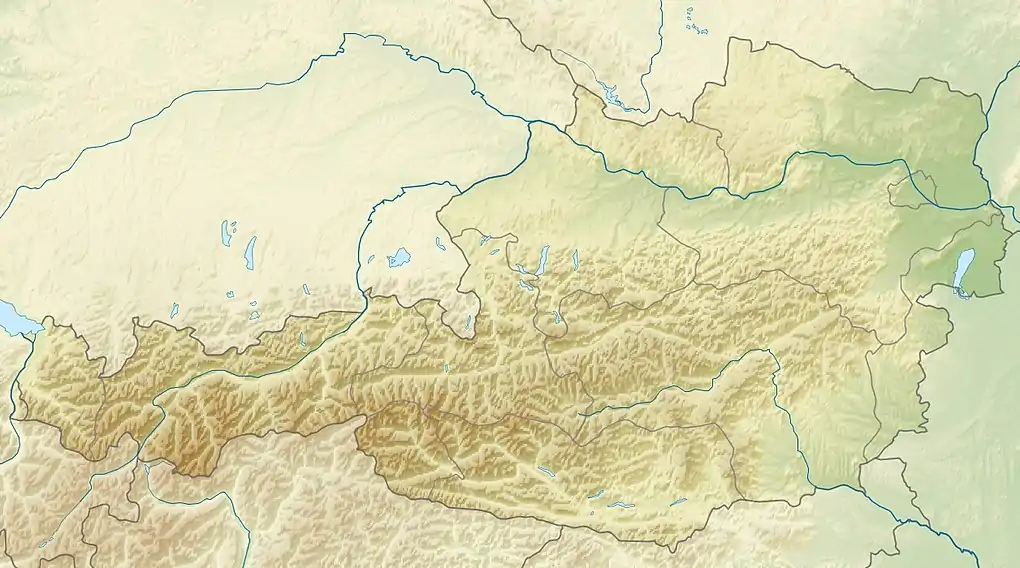Corona Formation
The Corona Formation is a geologic formation of the Carnian Alps at the border of Austria and Italy. It preserves fossils dating back to the Gzhelian stage of the Late Carboniferous period.[1]
| Corona Formation Stratigraphic range: Early Gzhelian ~303–302 Ma | |
|---|---|
.jpg.webp) Monte Corona, Austrian side | |
| Type | Formation |
| Unit of | Pramollo Group |
| Underlies | Auernig Formation |
| Overlies | Pezzul Formation |
| Thickness | 300 m (980 ft) |
| Lithology | |
| Primary | Conglomerate |
| Other | Sandstone, mudstone |
| Location | |
| Coordinates | 46.5°N 13.3°E |
| Approximate paleocoordinates | 10.9°N 23.7°E |
| Region | Kronalpe Udine |
| Country | |
| Extent | Carnian Alps |
| Type section | |
| Named for | Monte Corona |
 Corona Formation (Austria) | |
The 300 metres (980 ft) thick formation comprises deposited in a deltaic environment. The Corona Formation has provided fossils of fish, brachiopods, a bryozoan, an insect, fossil flora including trunks and ichnofossils ascribed to Limnopus. The tracks from the Corona Formation include the oldest record of tetrapod tracks from the Southern Alps.[2] The rugose coral Amplexus coronae was named after the formation.
Description
The Corona Formation was defined as a formation by Venturini in 1990.[3] It is the lowermost Gzhelian unit in the late Pennsylvanian Pramollo Group, overlying the Kasimovian Pizzul Formation and overlain by the Auernig Formation in the Carnian Alpine border region of Austria and Italy. The mountains Monte Auernig, Monte Carnizza and the eponymous Monte Corona are composed of the formation. The formation is a 300 metres (980 ft) thick succession, characterized by alternating quartz conglomerates, sandstones and mudstones. The conglomerates are coarse infillings of distributary channels in a deltaic environment.[4] The formation is characterized by cyclothems (parasequences) of 30 to 40 metres (98 to 131 ft) thick.[5]
Fossil content
The Corona Formation has provided fossils of:[1]
- Fish
- Insects
- Palaeodictyoptera
- Dictyoneuridae
- Arltia carnica[7]
- Dictyoneuridae
- Palaeodictyoptera
- Rugose corals
- Zaphrentis omaliusi[8]
- Lopholasma carbonaria[8]
- Amplexus coronae[8]
- Strophomenata
- Bryozoa
- Rhombocladia delicata[10]
- Foraminifera
- Ichnofossils
The tracks of Limnopus from the Corona Formation represent the oldest record of tetrapod tracks from the Southern Alps.[2]
Flora
The formation has also provided abundant, well-preserved and diverse plant assemblages in coal-rich levels of up to 30 centimetres (12 in) in the fine sandstones and shaly levels of the Corona Formation. Therein, sphenophyte trunks with a diameter of up to 20 centimetres (7.9 in) are preserved in situ.[2] The genus Lebachia, typically known from the Permian, is not found in other Carboniferous strata in the Alps.[14] The flora is of importance as one of the earliest examples of rebound after the Carboniferous rainforest collapse.
- Acitheca polymorpha[15]
- Annularia carinata[16]
- Anthracoporella sp.[17]
- Calamites carinatus[18]
- Lepidodendron cf. subdichotum[15]
- Linopteris neuropteroides[19]
- Neuropteris cordata[19]
- Paripteris cf. linguaefolia[15]
- Pseudomariopteris busquetii[19]
- Alethopteris sp.[15]
- Pecopteris sp.[15]
- Polymorphopteris sp.[16]
See also
- List of fossiliferous stratigraphic units in Austria
- List of fossiliferous stratigraphic units in Italy
- Bajo de Véliz Formation, contemporaneous fossil flora-bearing formation of Argentina
- Ganigobis Formation, contemporaneous fossil fish-bearing formation of Namibia
References
- Corona Formation at Fossilworks.org
- Kustatscher et al., 2018, p.38
- Ronchi et al., 2012, p.305
- Marchetti et al., 2020, p.35
- Vai & Venturi, 1997, p.179
- Dalla Vecchia, 1988, p.54
- Brauckmann & Hahn, 1983, p.246
- Hubmann et al., 2003, p.67
- Pecar, 1986
- Ernst, 2005, p.70
- Vachard & Krainer, 2001, p.186
- Vachard & Krainer, 2001, p.188
- Marchetti et al., 2020, p.37
- Ronchi et al., 2012, p.308
- Ronchi et al., 2012, p.309
- Kustatscher et al., 2018, p.39
- Samankassou, 2003, p.205
- Kustatscher et al., 2018, p.40
- Kustatscher et al., 2018, p.44
Bibliography
- Marchetti, Lorenzo; Giuseppe Muscio; Fabio Massimo Petti; Gian Luigi Pillola, and Daniel Zoboli. 2020. The Carboniferous tetrapod ichnoassociation from Italy. Journal of Mediterranean Earth Sciences 12. 31-39.
- Kustatscher, Evelyn; Hendrik Nowak; Stanislav Opluštil; Josef Pšenička, and Luca Simonetto. 2018. The Carboniferous flora of the Carnic Alps - state of the art. Gortania - Geologia, Paleontologia, Paletnologia 40. 33-47. ISSN 2038-0410
- Ronchi, Ausonio; Evelyn Kustatscher; Paola Pittau, and Giuseppe Santi. 2012. Pennsylvanian floras from Italy: an overview of the main sites and historical collections. Geologia Croatica 65. 299-322.
- Ernst, Andrej. 2005. Upper Palaeozoic Bryozoa in Carnic Alps, Austria (a review). Denisia 16. 69-74.
- Hubmann, Bernhard; Susanne Pohler; Hans-Peter Schönlaub, and Fritz Messner. 2003. Paleozoic Coral-Sponge Bearing Successions in Austria. Berichte der Geologischen Bundesanstalt 61. 1-91.
- Vachard, Daniel, and Karl Krainer. 2001. Smaller foraminifers, characteristic algae and pseudo-algae of the latest Carboniferous / Early Permian Rattendorf Group of the Carnic Alps (Austria/Italy). Rivista Italiana di Paleontologia e Stratigrafia 107. 169-195.
- Vai, Gian Battista, and Corrado Venturini. 1997. Moscovian and Artinskian rocks in the frame of the cyclic Permo-Carboniferous deposits of the Carnic Alps and related areas. Geodiversitas 19. 173-186.
- Dalla Vecchia, F.M. 1988. First Record of a Petalodont (Petalodus ohioensis Safford, 1853) from the Alps. Gortania - Atti Museo Friulano di Storia Naturale 9. 47-56.
- Pecar, J. 1986. Upper Carboniferous and Permian mesolobid chonetacean brachiopods of Karavanke Mountains (Yugoslavia) and Carnian Alps (Italy). Geologija 28/29. 9-53.
- Brauckmann, C., and G. Hahn. 1983. Ein Palaeodictyopteren-Flügel aus dem Ober-Karbon der Karnischen Alpen. Carinthia II 93. 245-251.